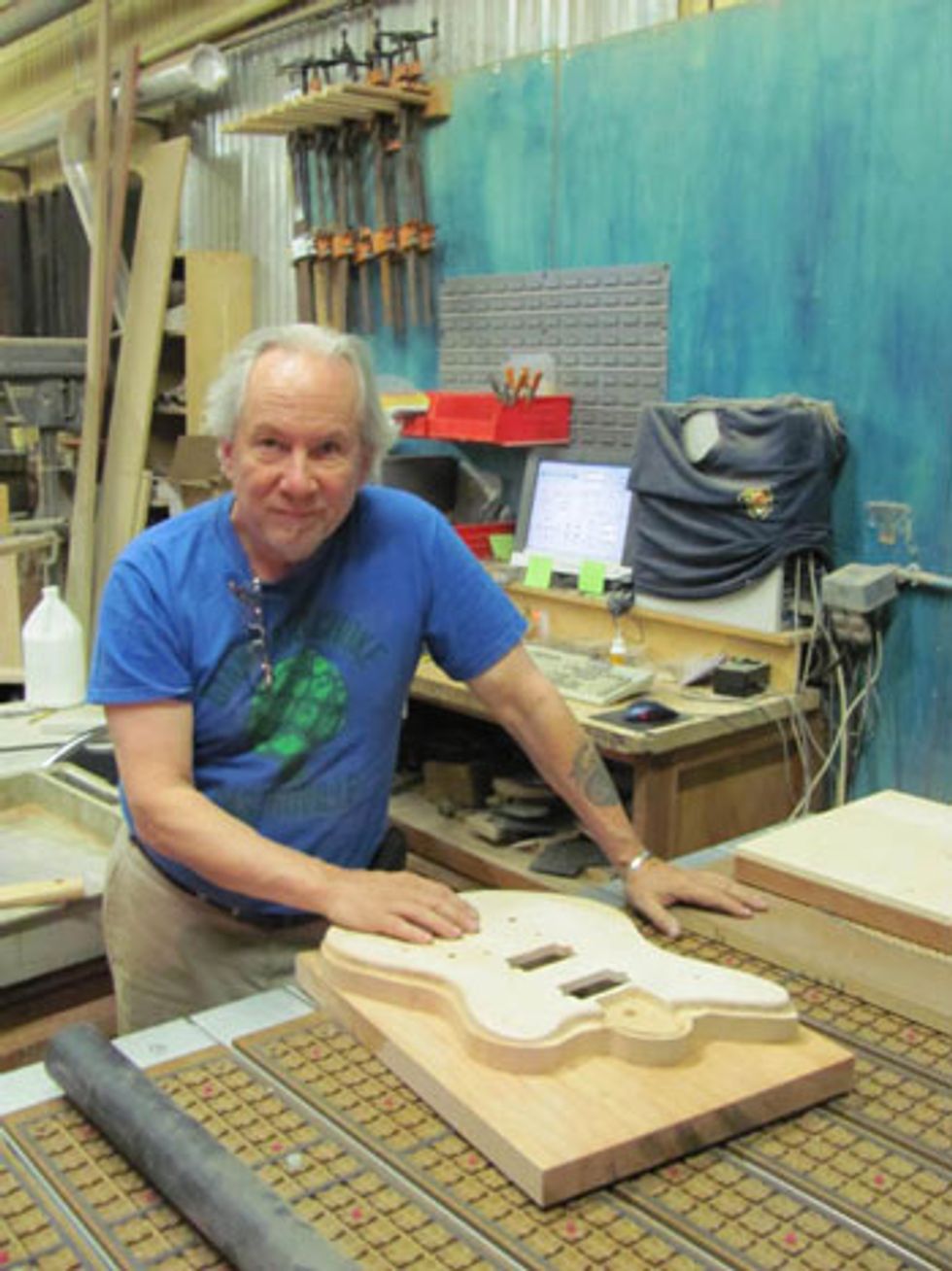 Rick Turner, pictured with a partially-finished Henman body, is overseeing production of the boutique brand's new guitars. |
Rick's a busy man, he currently runs three guitar companies—Renaissance Guitars, Rick Turner Guitars, and Compass Rose Guitars. He also co-owns D-Tar along with Seymour Duncan. Together they make high-end, DSP-driven piezo pickups and preamps for acoustics. Rick is also now deeply involved with Henman Guitars, overseeing the production of the boutique electrics that are being built at his shop. The collaboration came about when Henman Guitars designers Graham and Paris Henman parted ways with their original partner and guitar builder, Scotty Bevilacqua [the company was originally Henman-Bevilacqua]. Searching for a new production solution, the duo found Turner. Turner-built Henmans should be available in the early part of 2010. As if that is not enough, Rick Turner also helped establish the Buddy Holly Guitar Foundation, a nonprofit group dedicated to providing guitar education to youths who otherwise would not have such access.
I recently met Rick at his factory in Santa Cruz, California to discuss his latest projects.
Tell me how you became involved with Henman Guitars.
I met Graham [Henman] at my friend David Neely's guitar repair shop in Hollywood. I just sort of let the word drop that I had a guitar factory and we were operating under capacity, and we that had a CNC machine for the carving of the parts. For instance, this neck is straight off the machine. That's' no hand carving whatsoever, that's right off the machine.
Rick hands me a beautiful, sleek, unfinished neck from a stash under a counter. It's a three-piece laminated Spanish cedar number and even though it needs finish sanding, it feels great. He also shows me one with a heavy-duty truss rod in it that is designed to absorb all the string tension, making the neck little more than something to wrap your hand around while playing. I am not exaggerating when I say every nook and cranny of Rick's factory is packed with similar gems and innovations.
So you just program the machine and...
And design the fixtures to hold the parts. Then, I just let the machine take as much time as it needs to do the job you want it to do. One of the issues when we came into the project was that we had a whole bunch of work in progress. So we've had to try to figure out how to tool up to utilize the work in progress, 'cause there was like four grand worth of fingerboards, and we're not going to not use these ebony finger boards, you know.
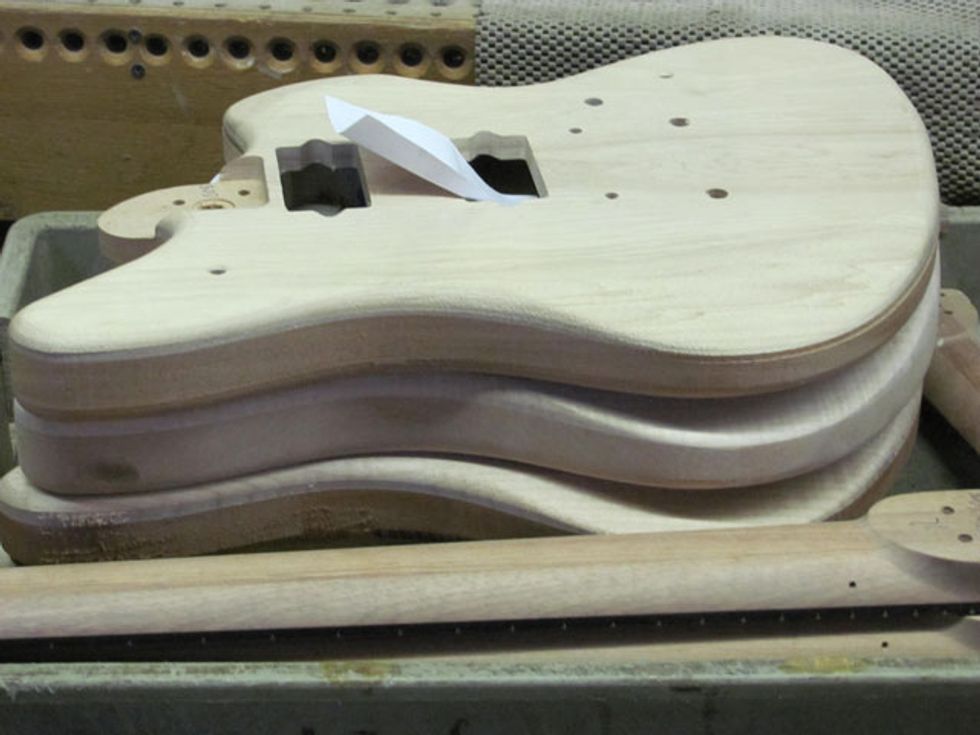
A stack of Henman bodies sits fresh off the CNC
Are all the fingerboards for the Henmans ebony?
We do have some rosewood ones, but right now [our focus] is ebony.
How long does it take to make a neck with a CNC machine?
It took me about three days of machine time to carve about 77 necks.
Is that fast? I don't have a benchmark...
That's fast. It's really good and our thing is, I'd rather it take a half an hour more on the machine and cut out 15 minutes worth of hand sanding.
And how long did it take you to set up that machine?
It took a considerable amount of time. It's a considerable investment, Graham [Henman] is paying for the tooling and he has a long view of this.
How many necks do you have to go through before you get it right on the machine?
Three. I've been around the block enough to where I understand how to tool up for this stuff. I'm not a CAD CAM guy myself, but I know enough about production to where I can say, "OK, here's the sequence of events; here are the fixtures that we are going to use; here's how we are going to hold the parts; here's the first operation, so I'm good at that stuff. I'm also at a point in my career where my ego is not on the line. I don't have to build everything of my own design.
You've nothing to prove.
Well, [I like] the idea of working with somebody who is so different in his approach and in his aesthetic and for whom I have very high regard and respect. I'd have never designed these, but I love helping Graham achieve his ideal and throwing my own thing in. For instance, these guitars have back plates on them. So I figured out how to eliminate the back plate. The new guitars, rather than have two huge, [and] frankly, ugly back plates, I've opened up a tunnel and we can drop the electronics in and fish them out. It's kind of like a [Gibson] 335, where we drop things in the pickup hole and the pickups selector switch goes up and through. So we've eliminated parts [and] streamlined the process. I'm designing a circuit board that the pots will be mounted on. So the tone control will be push-pull for single-coil /humbucker mode. Then, if you are on both pickups, it'll hum-cancel. And then you pull out on the volume control and it bypasses the volume and tone control and takes the pickup, the output of the pickups selector switch, direct to the output jack.
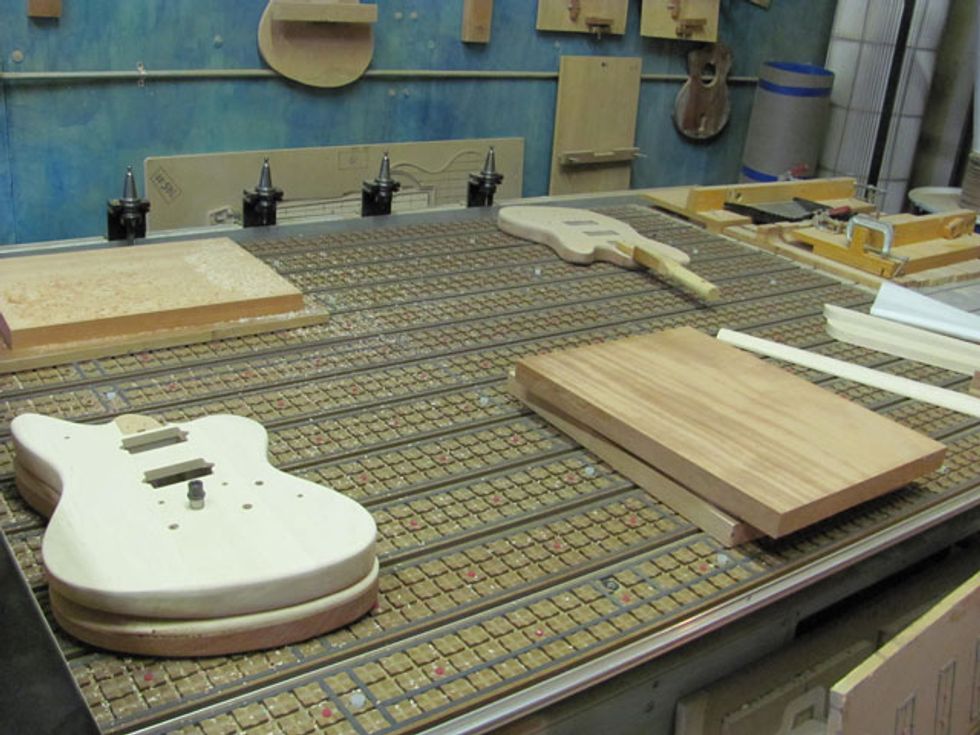
Henmans on the CNC
What kind of pickups?
We're going with some of Seymour [Duncan]'s pickups. And one of the differences is we are going to put five conductor connectors on it. So if you want to change pickups, just pop the pickup out, unplug it, and be able to drop in another pickup.
You know I've wondered why pickups still don't have plugs.
Well, these will! [laughs] And it's not that people are going to do it a lot. But for us, just in production, it'll save time and it'll also enable Graham to offer different pickup options. So pickups can be the last things that go into the instrument. So you can get two Seth Lovers or a Pearly Gates and a Seth, whatever! Seymour can also do custom pickups for us, so that's how I'm getting to add some of my own stuff. And then my oldest son is a genius metalworker and he is going to be in charge of all the custom metal stuff—the textures, the anodizing, and the plating.
I point to a partially finished Henman on the wall and admit I don't recognize the tuners.
Well, they're Sperzel tuners with Graham's custom designs. Even the knobs are custom-made. I mean, you can't buy those! The pickup rings [are also] custom made. None of this is cheap or easy to make.
What kind of bridges will the Henmans use?
We are going to start off offering three different options—the Tone Kings, the Tune-o-matic with a stop tailpiece, and, for the time being the Tune-o-matic with a Bigsby, although eventually I want to go with a roller Tune-o-matic with a Bigsby.
And will they stay in tune with the Bigsby?
[Sighs] Not as well as I'd like to see it stay in tune.
And are you willing to go the Floyd Rose locking route, or is that too much hardware?
It's too much hardware, and by the way, I hate calling them tremolos 'cause they're not.
I know!
They're vibratos! [Laughs] The other vibrato that we are going to go with in the beginning will be Rick Huff's Skyway. They're really interesting. It doesn't utilize a knife-edge, it works on this pair of flextures, and they are like forever springy hinges and they do not wear out. And they also seem to couple string vibration better to the body than most other vibrato units. That's going to be a very high-end unit—a very expensive unit, but tuning-wise it is fabulous.
Rick lays out for me on a table, select hardware including a Skyway vibrato. Rick patiently shows me the sleek, clean inner working of the vibrato, which has surprisingly few moving parts. It is plain to see Rick digs the ingenuity of the design as much as he does its tuning stability and tonal considerations. All the pieces Rick has laid out, including the aluminum neck inlays, are destined to become part of a Henman guitar. That each piece is well made with excellent aesthetic is easy to recognize. But I am only seeing the pieces. As a guitar maker, Rick sees the sum of these parts, and can hear in his head what they are capable of when used together. He also sees the challenges.
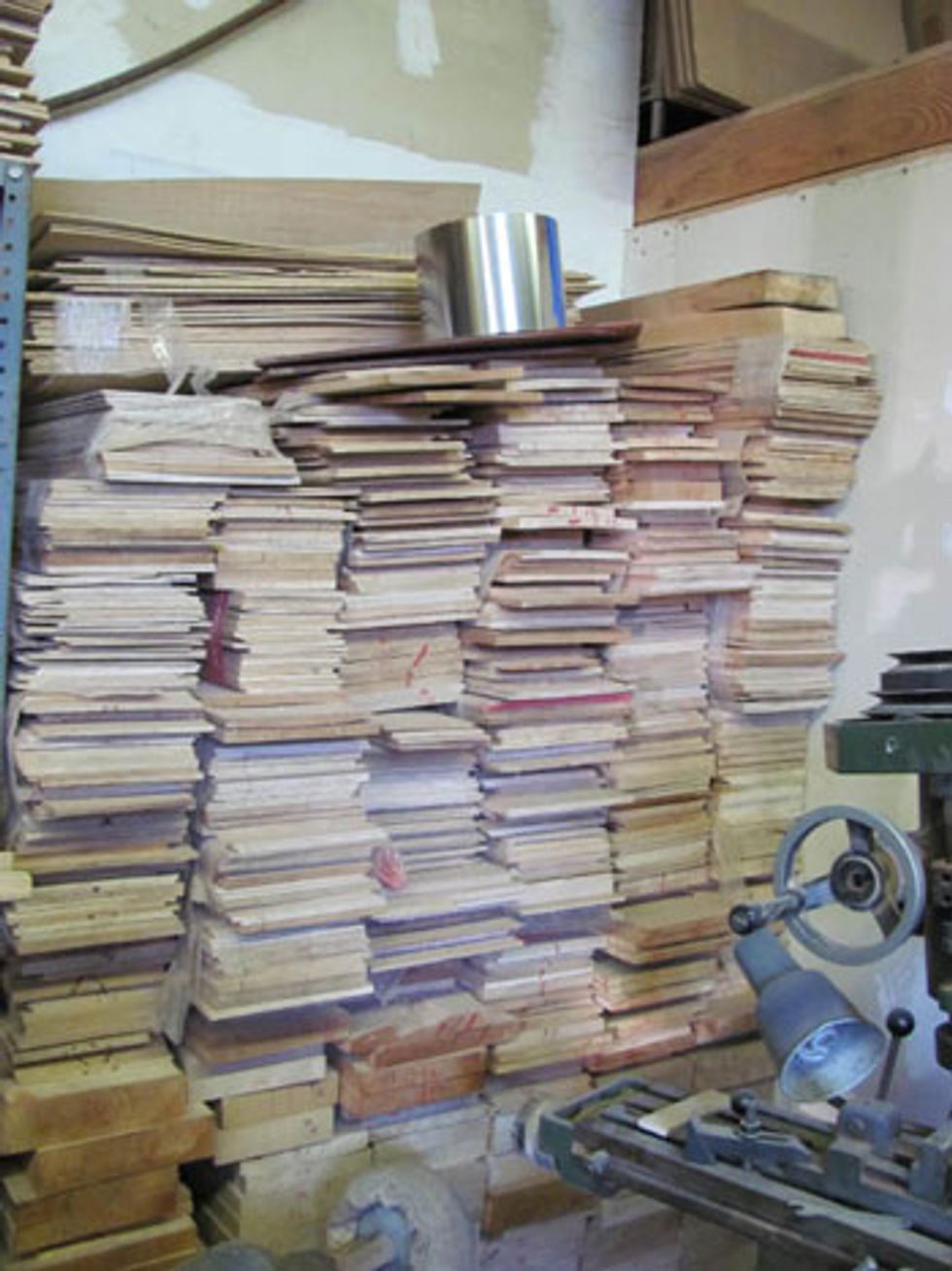 A stack of flame maple in Rick's workshop |
On the word fun, Rick's already bright eyes begin to twinkle and he asks me to follow him. We navigate around large wood cutting machines, an antiquated pickup winding machine that Rick still uses for his famous Model Ones, and more piles of precious wood, including, stacks of flame maple and rare woods like Tasmanian Black Sassafras. We enter another luthier's station packed with acoustic guitar sides and bodies in various degrees of completion. He takes a finished body from a shelf, holds it up and says,
That is a 1943-spec Gibson J-45. That's Buddy's guitar, with a few interesting changes. The bottom end block is Baltic Birch because it's better. Aside from that, you could slip that into the Gibson production line of 1943 and they might actually say, "That looks a little too good!" [laughs] These are all put together with traditional hot hide glue, and with the original woods mahogany and Adirondack spruce. I'm working with a guy named John Thomas who was an advisor on this project and who is writing the definitive book on Banner Era Gibsons, and so it's just a hell of a project. This also came about from last year's NAMM show.
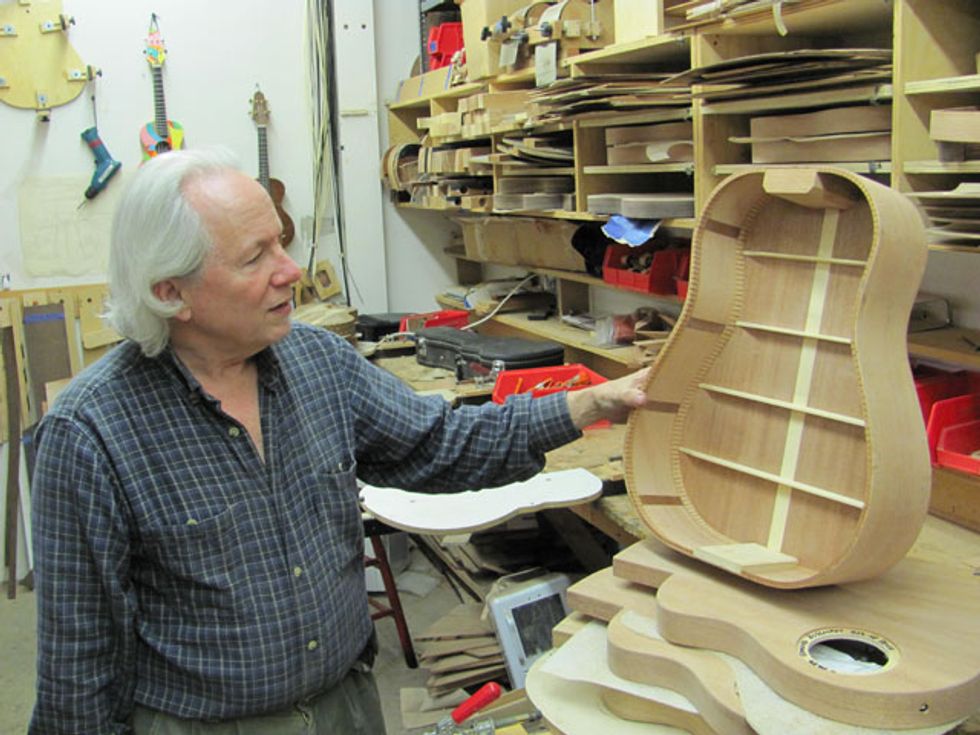
Rick pictured with one of the new Buddy Holly J-45 bodies he's working on for the Buddy Holly Guitar Foundation
You restored Buddy Holly's original guitar, yes?
Yes. Gary Busey bought the guitar from the proceeds of the movie [The Buddy Holly Story]. He bought the guitar for $270,000, and he brought it to me. I was working at Westwood Music in L.A. It was cracked from waist to waist right through to the end block, and Buddy had made a leather cover for it with his songs on it. So I said, Gary, I'm going to have to take the cover off to do this repair job. And he said, "No, no, no, man, you can't take the cover off. Buddy sewed that on there." And I said, "Okay..." So I did all the repair work through the sound hole. I restored it, I refretted it, and Gary gave me the original frets, so I had Buddy Holly's frets. So in December of last year [Buddy Holly enthusiast] Peter Bradley gets in touch with me and says, "I understand you have Buddy Holly's frets, I am a big Buddy Holly fan and would you be willing to sell me the frets?" And I was thinking, "Well jeez, they're just sitting here in a drawer so I might as well." So I sold him the frets and then he ordered three guitars from me. And then I'm at the NAMM show and he gets in touch and he says, "Will you be willing to make 18 replicas of Buddy's guitar and put one of the frets in each of the guitars?"
And I said, "Yeah, that's a really nice project." 'Cause, you know, we had being doing more and more acoustics, and it's sort of what I came out of anyway, and I'd been wanting to make more acoustic guitars. And one thing led to another and at one point he asked if I could get one to Graham Nash and I said sure, I had been doing stuff for Graham [Nash] for years. And then I realized Peter didn't have a real clear plan on selling the guitars, he was just kind of looking to distribute them. So I said to him, instead of giving these guitars away, why don't you loan them—set up a nonprofit foundation that will loan these guitars out for a given period of time with a proviso that the musicians who have the guitars use them in some way to raise money for a worthy musical cause like music education. And, he went for it. I found a leather worker in Austin to do these covers and then several of us went down to Dallas and we met with Maria Lena Holly, Buddy's widow, who practically drunk us under the table. [Laughs] She is just a hoot! She is really fun. So we have her full approval on this. We can use Buddy's name and the whole thing.
It sounds like a very interesting project.
It's been an amazingly fun project. And John Thomas, who is the expert on this era of Gibson—the Banner Era Gibsons—I asked him to get involved and it turns out he's an attorney. So he helped set up the nonprofit foundation and the first two musicians I invited to partake were Graham Nash and Jackson Brown, and they're both on the board of directors now. They will both get guitars. The idea is they can re-up in two years. And within those two years, you've got to do something for the Buddy Holly Guitar Foundation. And the foundation will give out money to whatever the board chooses to do. There's a regular board of directors and a list of worthy recipients.
Rick goes on to show me all the components that make up these J-45 Buddy Holly replicas. He is clearly excited about the project. He talks a bit about how he's at a stage of his life where it's time to give back. And while he is proud to be a member of this foundation, he quickly diverts attention from himself back to the instruments. He shows me one of the leather coverings made for these instruments. It looks exactly like the oft--photographed original that Buddy himself made.
That must cut the heck out of the sound.
Well you know the amazing thing is, you would think it would but it doesn't cut as much as you would imagine. What it does is make all of the sound come out of the sound hole and it almost makes it sound like it's running though a compressor. It does this acoustic compression thing to the tone.
Will these guitars have any electronics?
We are going to put pickups in all of the guitars so they will be stage worthy.
What kind of pickups?
They will have D-Tar Dual Source Wavelengths.
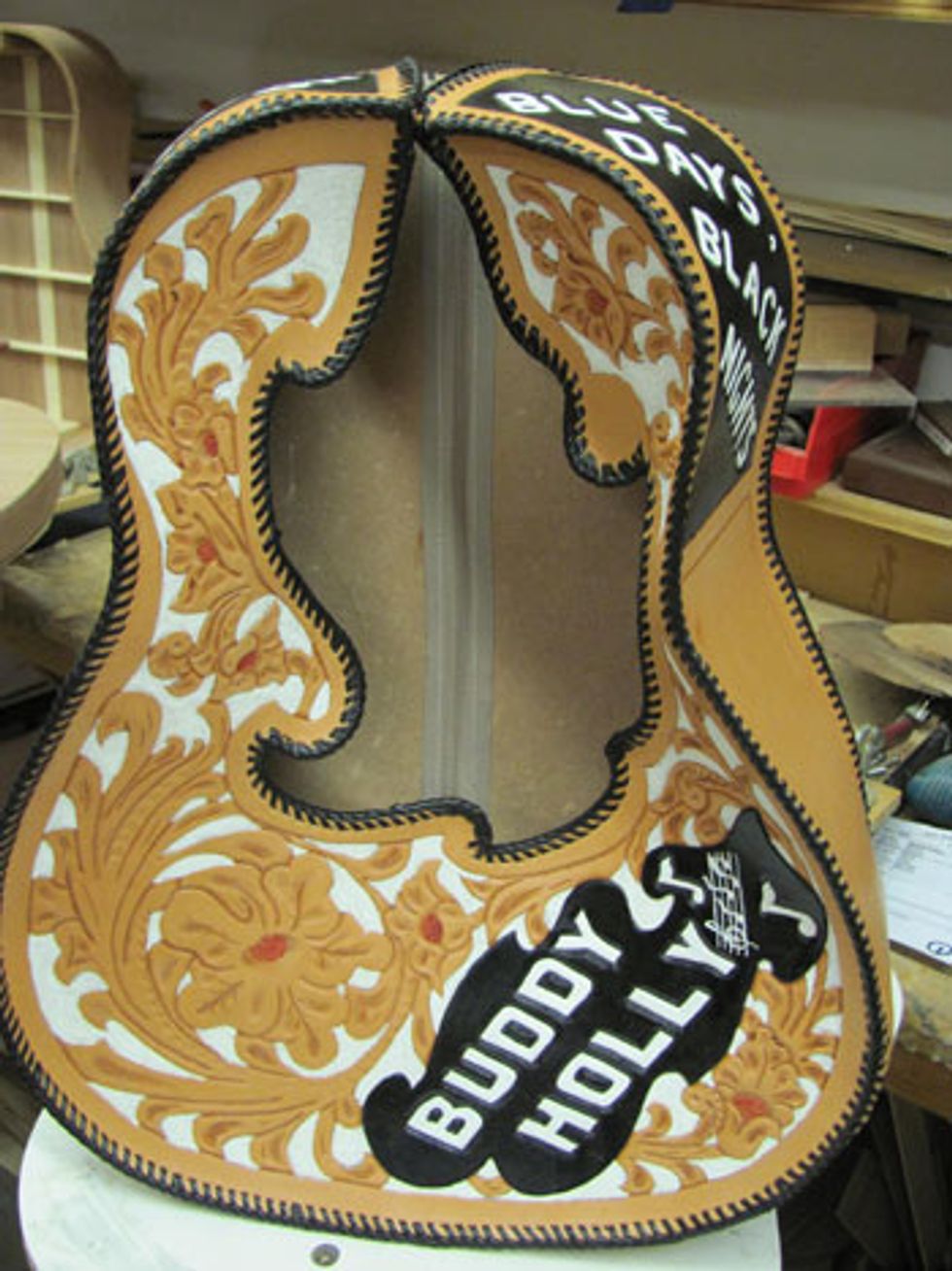 A custom leather cover that will be used on one of the 18 J-45 replicas that Turner is building using Buddy Holly's original fretwire. |
Well, Another interesting thing is that the 1943 J-45s had maple and walnut necks painted so brown you would think it was mahogany. And it was only one year that they did that. John [Thomas] thinks that the necks may have been leftover from Recording King Ray Whitleys. Recording King was another spin-off brand of Gibson's. Ray Whitley was a country star and they had these necks in the natural color. So anyway, I went back to the original specs on the necks, so I'm doing it like Gibson would have done, like as a production run, same for all the backs, all the sides.
Are you just making the 18?
No, I'm making more. 18 will have the leather covers and will have the frets. And then we will continue to make this style of guitar, and we will probably do some naturals with a natural neck. And I'd like to do some where we stain the mahogany body like we do the Model Ones and do the black binding and tie it together with my other acoustic stuff and do the back with overlays like I do with a lot of my other stuff.
So out of all the guitars that you've made over the years, which one symbolizes the Rick Turner sound? The Model One? The RS 6? Or have you not yet made it?
They're all my babies. I like them all.






![Rig Rundown: Russian Circles’ Mike Sullivan [2025]](https://www.premierguitar.com/media-library/youtube.jpg?id=62303631&width=1245&height=700&quality=70&coordinates=0%2C0%2C0%2C0)

















